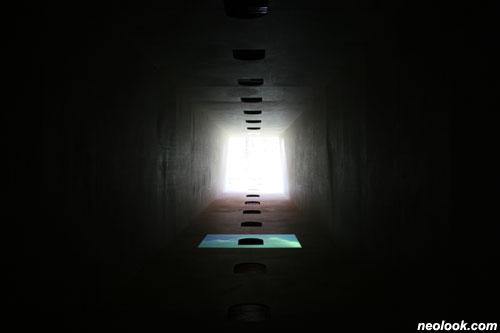- ● homepage
- ● archives
- ● restoration
- ● books
- ● big banners
- ● post board
- ■ neo's search
- ■ about us
- ■ 게재방법 안내
- 개인정보처리방침

- [email protected]
- Tel. 02_335_7922
- Fax. 02_335_7929
- 10:00am~04:30pm
- 월요일~금요일
- 3/3(월) 대체공휴일

박준하展 / PARKJUNHA / 朴峻河 / installation 2012_1122 ▶ 2012_1129
● 위 이미지를 클릭하면 네오룩 아카이브 Vol.20080323d | 박준하展으로 갑니다.
초대일시 / 2012_1122_목요일_05:00pm
* 본 전시는 기업의 사회적 책임을 다하기 위해 한국전력의 문화예술지원 사업으로 이루어집니다.
후원 / 한국전력공사
관람시간 / 10:00am~06:00pm / 주말,공휴일_10:00am~05:00pm
한전아트센터 갤러리 KEPCO ARTCENTER GALLERY 서울 서초구 쑥고개길 34(서초동 1355번지) 1관 Tel. +82.2.2105.8190~2 www.kepco.co.kr/gallery
무너진 꿈속에서 피어나는 과정의 신화 ● 갤러리에 터널이 하나 놓여있다. 갤러리의 밖에서부터 시작되어 전시장 안 깊숙한 곳까지 다다른 듯 보인다. 터널 끝에 불빛이 나를 인도한다. 터널을 지나는 동안 양쪽 벽면에 가지런히 놓인 창문들에서는 서로 다른 풍경이 펼쳐진다. 하지만 어느 순간부터인가 답답함이 느껴진다. 터널이란 것이 구조적으로 답답할 수밖에 없는 것이지만, 그래도 이 터널에 들어설 때는 비교적 넉넉한 크기의 입구여서 답답함을 덜 느꼈지만, 터널을 지나면 지날수록 천장과 복도 폭이 점차 좁아져 터널 끝에 다다랐을 때는, 창밖 풍경을 감상하기는커녕 몸을 웅크려 터널을 빠져나가기 바쁘다.

- 박준하_woher, wohin_영상설치_240×240×1200cm_2012_부분
하지만 터널 밖은 터널 안과 달리 시원한 광경이 펼쳐진다. 터널의 창문을 통해 봤던 하늘 영상과 알 수 없는 문자와 기호로 조합된 영상이 다른 한쪽에 비춰지고 있다. 좁고 어두운 문자/기호 영상이 있는 공간보다는 비교적 넓게 트인 하늘 영상 쪽으로 몸을 움직인다. 그리고 내가 지나온 터널을 바라본다. 그리고 깨닫는다. 그것은 터널이 아니라 하나의 건축물이 쓰러져 있는 모습이라는 것을. 작가는 작업노트에서 "작업의 소재가 된 것은 중국 시안에 있는 탑이다. 탑의 내부는 어둡고 작은 빛들이 스며들고 있었다. 한층, 한층 오를 때마다 좁아지고 결국엔 몸을 돌리기조차 힘들어진다. 그러나 이 좁은 문을 지나면 우리는 하늘 안에 놓여진다. 그곳에서 나는 하늘과 땅의 중간이 아닌 하늘 속에 들어있는 느낌이 들었다."라고 썼다.
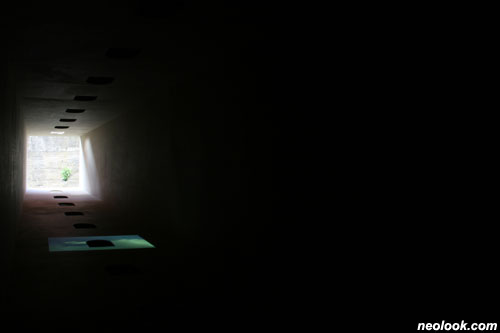
- 박준하_woher, wohin_영상설치_240×240×1200cm_2012_부분
그렇다. 이 건축물은 바로 탑이었다. 작가는 중국 시안에 있는 34미터 높이의 석탑을 경험하고 그 기억을 재구성한 것이다. 이 작품은 2007년 독일 푈클링엔에서 "Woher, wohin"란 제목으로 소개된 적이 있는데, 그 때 이 작품은 세계문화유산으로 지정된 제철소의 수공방길에 비어 있는 한 작은 건물에 설치되었다. 따라서 당시 이 작품은 그 지역의 장소성이 강하게 투영되는 방식으로 표현되었고, 그렇게 읽혔을 것이다. 하지만 이번 개인전은 갤러리라는 중립적 성격의 공간에 설치되어 무엇보다도 작가가 왜 이 작품을 구상했는지에 대해 좀 더 분명하게 읽을 수 있다.

- 박준하_woher, wohin_영상설치_240×240×1200cm_2012_부분
나는 박준하의 이 작품, 이 공간에서 인간의 무너진 꿈을 본다. 끊임없이 욕망을 추구한 인간의 결말. 마치 하늘과 맞닿으려 했던 바벨탑 축조의 비극, 결국 서로 다른 언어를 가지게 된 그 저주를. 하지만 나는 이 작품에서 신과 인간의 이분법적 대립의 결과였던 그것과는 별개로, 하룻밤 새 천불천탑을 세우면 천지개벽을 이룰 수 있다는 믿음으로 도선국사가 염원했던 운주사 천불천탑의 설화 이미지가 더 떠오른다. 마지막 석불을 세우려다 결국 새벽닭이 우는 바람에 천지개벽을 꿈을 버려야 했던 그것. 원래 당당히 서 있어야 할 부처님이 '와불'이라는 이름으로 누울 수밖에 없었던 그 기억이 나의 가슴에 더 와 닿는다. 즉 욕망 추구의 결말이기보다는 좋은 세상을 꿈꿨던 한 작가의 염원이 이 작품 안에 고스란히 담겨 있다는 생각이다. 전시장 안팎을 연결하는 쓰러진 탑, 탑의 창문을 통해 보이는 새로운 풍경. 어쩌면 이것은 일어서지 못한 운주사의 와불이 이 세상을 바라보는 시선일지도 모르며, 그리고 그것은 이 세계를 살아가는 작가 박준하의 세상을 보는 시선일 수 있다.
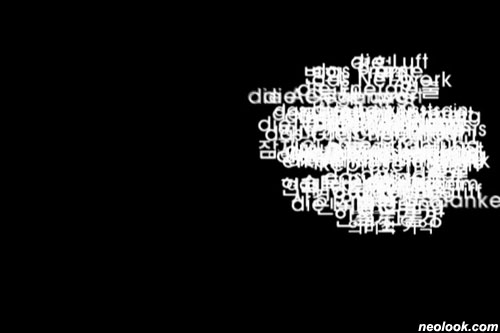
- 박준하_woher, wohin_영상설치_2012_부분
나는 박준하의 시선에서 단순히 무너진 꿈이 아닌 새 희망을 본다. 쓰러진 탑과 욕망 추구의 비극 너머에 아련히 비치는 새 희망. 한국과 독일, 그리고 중국에서 채집한 하늘의 영상은 무너진 탑 속에서 참회하듯 비집고 나온 관객에게 작가가 중국의 그 석탑에서 느꼈던 탁 트인 하늘의 느낌을 부여한다. 하지만 그것도 잠시, 갤러리를 나오려면 어둡고 좁은 골목에서 해독불가능한 문자/기호를 만나야 한다. 그 곳을 지나 다시 만나게 된 현실. 과연 관객들은 박준하의 이 스펙트럼 속에서 무엇을 느낄까?
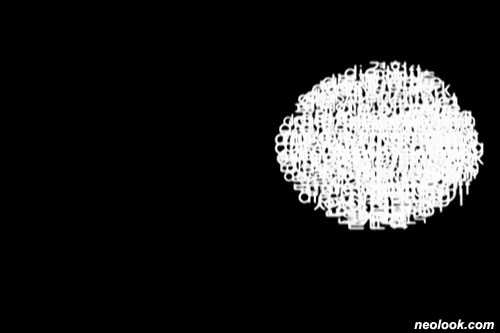
- 박준하_woher, wohin_영상설치_2012_부분
어찌 보면, 박준하의 작품은 쓰러진 탑(터널)으로 상징화된 통로와 빛과 어둠이라는 단순한 스토리텔링처럼 보이지만, 나는 여기에서 박준하만의 신화를 찾을 수 있었다. 그것은 결말을 예측할 수 있는 신화가 아닌 여전히 진행 중인 신화, 즉 과정의 신화라는 점이다. 개인적 체험을 신화적 체험으로 승화시키는 데는 무한한 작가의 상상력이 요구된다. 그의 신화가 우리의 신화로 재탄생하는 순간, 그것은 쓰러진 탑, 무너진 꿈이 아닌 현실의 꿈이 될 수 있다는 기대를 품어본다. ■ 이근용
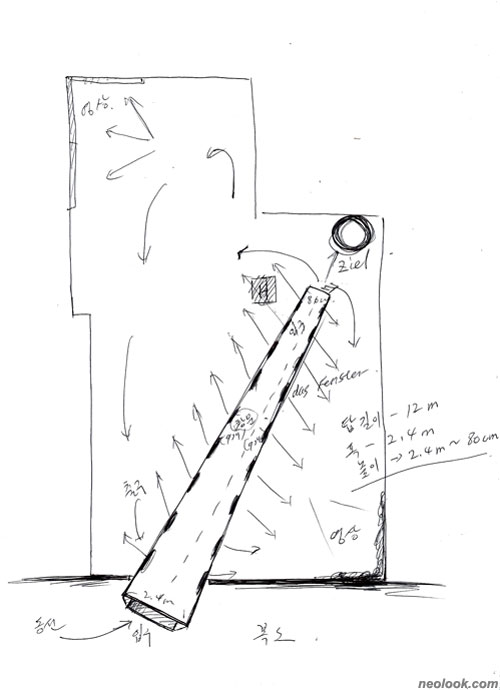
- 박준하_한전드로잉
"Woher,Wohin~" ● There lies a tunnel in the gallery. It seems to start from outside the gallery to reach its deeper inside. A light at the end of the tunnel guides me. While I pass through the tunnel, I see different landscapes being unfolded through the windows arranged neatly on both wall planes. From a moment, however, I seem to feet heavy. Although any tunnel has a stuffy structure, I felt less stuffy when I entered this tunnel because its entrance is relatively wide. ● But when I walked longer and longer, approaching the end of tunnel with it's ceiling and floor tapered, I was busy getting out of the tunnel by crouching my body, much less enjoying the views out the window. ● However, once you have got of the tunnel, you will have a sweeping view. One side features the image of the sky you saw out the window in the tunnel and the other side is dotted with the images combined by illegible letters and signs. You feel inclined to move toward the relatively wider sky image rather than the narrow and dark space dotted with letters / signs images. Then, I look back to the tunnel I have passed, And I am awakened; it is not a tunnel but a structure fallen. In his work diary, the artist writes, "The subject of the work is tower in Xian, China. Its inside was dark, being permeated dy the dim lights. when I was walking up step by step, the inside was narrower and narrower and the end, I could hardly turn around my body. However, once I passed the narrow passage, I found myself placed within the sky. There, I felt being within the sky, not between sky and earth." ● Yes, this structure is nothing other than a tower. The artist experienced the 34meter-high stone tower in Xian, China and thereby, reorganized his memory. This art work was once introduced at Voelklingen, Germany in 2007, then, with the title "Woher,Wohin~" At that time, the work was installed in small building on the road of workshops at a still mill site designated at a World Heritage Site.Hence, the work was presented so as to feature the locality of the site, and it might have been read so. At this solo exhibition, however, the work is installed in a space of the neutral character called 'gallery' so we can more clearly read, above all, why the artist conceived this work. ● In this work by Park Jun-ha or in this space, I see our frustrated dream. The end of our human beings pursuing our desire incessantly, the tragedy of Babel Tower with which our ancestors tried to reach the sky, and the result of the dichotomized confrontation between God and men, this work reminds me of the narrative image of Thousand Buddha Thousand Towers at Unjusa Temple built by the state priest Dosun who believed that the tower would bring about a new beginning of the world. The monk gave up his dream of a new beginning of thw world when his attempt to build the last stone Buddha statue was frustrated by a cockcrow at dawn. The Buddha statue that should have stood squarely could not but lie, being called 'Lying Buddha,' haunts me more vividly. I feel not that this work is an end of our human desire but that it contains an artist's desire of a better world intact. The fallen tower linking outside and inside of the gallery. The new landscape through the window of the tower. "The Lying Buddha' at Unjusa Temple that could not stand up seems to look at such landscape. And it may be a viewpoint from which Park Jun-ha look at this world. ● From Park Jun-ha's viewpoint, I see a new hope, not simply frustrated dream. A new hope dimly visible the fallen tower and the frustrated desire. The images of the sky sampled in Korea, Germany and China awaken the repenting spectators who have just got of the fallen tower of the sweeping sky felt by the artist from the stone tower in China. However, if you want to get out of the galley, you should meet the illegible letters and sings in the dark and narrow lane. The reality that you would meet again after the tunnel. What on each will you feel from such spectrum of Park Jun-ha's? ● In a sense, Park Jun-ha's work may look like a simple story-telling about passage, lights and darkness symbolized by the fallen tower (tunnel), but I could only find his own myth here. It is not a myth the end of which is predictable but a myth being still developed or in its process. Subliming an individual experience to a mythological level requires artist's infinite imagination. At the very moment. when his myth is reborn into our own one, it is expected that it will become a dream of reality. not fallen tower or frustrated dream. ■ LEEKEUNYONG
Vol.20121124i | 박준하展 / PARKJUNHA / 朴峻河 / installation

